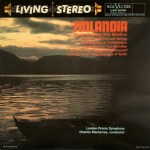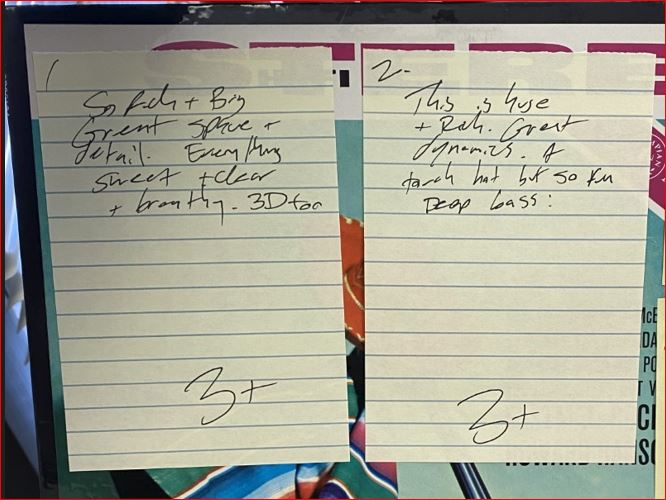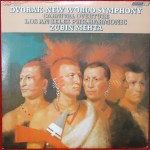More of the music of Gustav Holst (1874-1934)
Reviews and Commentaries for The Planets
Mars on the first side and Saturn on the second present serious challenges to any recordings of the work you may own, especially if you own the overrated Mehta recording on the TAS List.
Generally speaking, the White Hot copies stand apart from the pack with more top end extension, and/or more lower end weight. Our notes will typically say “extended highs and lows,” and those are hard to come by, on any record.
Let’s get to the specifics of the two movements we feel are the best test for The Planets as a whole.
The War Test — Side One
War, the first movement, has the string players “bouncing” their bows upside down to create the effect you hear. It’s not fingers plucking the strings; it’s the wood of the bows bouncing on the strings. The quality of that technique is so obvious and correct sounding on the good copies and so blurry and indistinct on the bad ones that you could almost judge the whole first side by that sound alone. When it’s right it’s really right.
And of course the players are spread out wider and the soundfield is so much more transparent when these types of sonic qualities are brought out. This bouncing bow test makes it easy to separate the better copies from the also-rans when it comes to smear, resolution, transparency and the like.
The Saturn Test — Side Two
This was the real revelation in our recent shootout (2013). We had on hand performances by Steinberg on DG, Previn and Boult on EMI, as well as Mehta and Karajan on London — well known and highly regarded Golden Age recordings one and all. (I gave up on the Solti with the London Phil years ago; that opaque later London sound just won’t cut it on the more resolving stereo we have now.) None of the above could match either the performance or the sound of Saturn on the EMI by Previn and the LSO.
The brass is so BIG and POWERFUL on EMI’s recording that other orchestras and recordings frankly pale in comparison. Until I heard one of our top EMI pressings show me brass with this kind of weight and energy, I simply had no idea it was even possible to play the work this powerfully. The lower brass comes in, builds, gaining volume and weight, then calms down, but soon returns and builds relentlessly, ever and ever louder. Eventually the trumpets break out, blasting their way forward and above the melee the heavier brass has created below.
Quite honestly I have never heard anything like it, and I heard this work performed live in late 2012! In live performance the members of the brass section, being at the back of the stage, were at least 100 feet away from me, perhaps more. When playing the best EMI pressings, the brass were right there in front of me, eight to ten feet away. This is of course unnatural and unrealistic, but that should take nothing away from the subjective power of the experience.
Only the conductor can stand at the podium, but the EMI producers and engineers (the Two Christophers in this case, Bishop and Parker) have managed to put the listener, at least in this movement, right there with him.
The EMI Sound
EMI’s are usually recorded with the aim of of producing more of a mid-hall perspective, which is somewhat distant for our taste. That’s just not our sound. We prefer the Front Row Center seats (especially at the prices we charge).
That said, when an EMI from the 70s is recorded, mastered and pressed properly, it actually sounds more like the real thing actually does, more like a live performance of orchestral music in a concert hall.
It’s uncanny how real the best copies of this record sound. For a recording of The Planets it has no equal in our experience.
The Performances
For audiophiles who love the work but are disappointed by most performances (a group that includes us to be sure), the good sound found on this copy is coupled with a superb performance. The best pressings of this record truly deserve their place on the TAS List. This 1974 release is widely considered one of the great recordings of The Planets. Previn is simply outstanding throughout. He’s not going after effects, he’s making all the pieces fit.
Of course it trounces the Mehta recording that many audiophiles, HP included, are seemingly enamored with. We certainly never have been. EMI knows how to make an orchestra sound like a seamless whole, unlike the Decca recording engineers who appear to take perverse pride in awkwardly spotlighting every section. (Was it a Phase 4 experiment gone wrong? That’s my guess.)
And the average London or Decca pressing of The Planets is lackluster, so opaque and smeary it’s barely second-rate, a fact that most audiophile record collectors have failed to appreciate since it first appeared on Harry’s Super Disc list.
VTA
Accurate VTA adjustment for classical records is critical to their proper reproduction. If you do not have an arm that allows you to easily adjust its VTA, then you will just have to do it the hard way (which normally means loosening a set screw and moving the arm up and down until you get lucky with the right height).
Yes, it may be time consuming, it may even be a major pain in the ass, but there is no question in my mind that you will hear a dramatic improvement in the sound of your classical records once you have learned to precisely adjust the VTA for each and every one of them. We heard the improvement on this record, and do pretty much on all the classical LPs we play. (All records really.) VTA is not a corner you should be cutting. Its careful adjustment is critical. Of course, so are anti-skate, azimuth and tracking weight. Our making audio progress section has a fair amount on turntable setup which might be worth checking out.


 More of the music of Jean Sibelius (1865-1957)
More of the music of Jean Sibelius (1865-1957)
 More Columbia Classical Recordings
More Columbia Classical Recordings

 The Music of Tchaikovsky Available Now
The Music of Tchaikovsky Available Now







